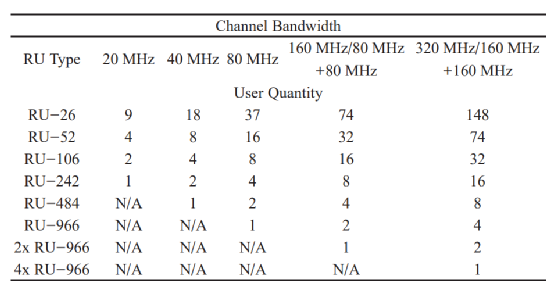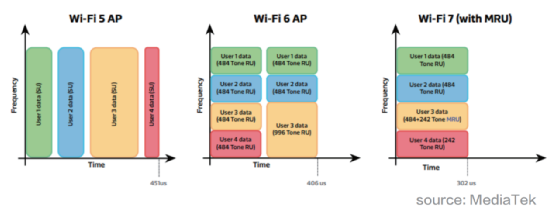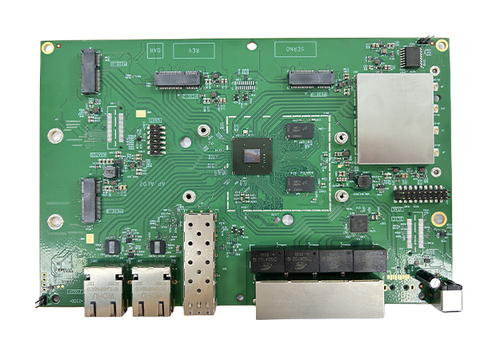IPQ9574/Breaking the speed boundary: exploring the innovative technologies of WiFi 7

In January 2020, the Wi-Fi (Wireless Fidelity) Alliance officially announced the opening of 6 GHz (5 925 MHz–7 125 MHz) and gave it a new name Wi-Fi 6E. In April of the same year, the US FCC (Federal Communications Commission ) also voted to open the 6 GHz spectrum as an unlicensed band and allow it to be used by Wi-Fi. Wi-Fi has also officially entered the "tri-band" era, in addition to Wi-Fi 6 and the previous generation Wi-Fi Among the 2.4 GHz and 5 GHz frequency bands used, Wi-Fi 6E can also operate in the 6 GHz frequency band.
In mid-2021, some mainstream Wi-Fi equipment manufacturers on the market began to mass produce and sell Wi-Fi 6E products. Starting from 2022, Wi-Fi 6E has become the mainstream specification on the market, regardless of the bidding of European and American operators. The solution is still for high-end home Wi-Fi network equipment such as home routers, meshes, wireless signal extenders and even high-specification laptops, etc., which have included Wi-Fi 6E in the basic specifications. Just as everyone is gearing up to welcome Wi-Fi When the 6E era arrives, Wi-Fi 7 has occupied most of the Wi-Fi industry and technology-related pages at lightning speed. Why does Wi-Fi 7 attract most people's attention? What new technological innovations does Wi-Fi 7 have compared to previous Wi-Fi technologies? What's its current status? Below we will discuss these issues.
What is Wi-Fi 7
Before we discuss Wi-Fi 7, let’s first review the evolution and technical highlights of past generations of Wi-Fi specifications. At the end of 2018, in order to simplify the naming of complex Wi-Fi standards, Wi-Fi Alliance officially renamed the original 802.11ax to Wi-Fi 6. At the same time, retroactively, the existing 802.11ac was changed to Wi-Fi 5. , 802.11n was renamed Wi-Fi 4

In 2020, Wi-Fi 6E came out immediately after Wi-Fi 6. Wi-Fi 6E opened the 6 GHz frequency band for Wi-Fi to use. Since then, Wi-Fi has officially entered the "true tri-band" architecture

The Wi-Fi standard currently remains at Wi-Fi 6E. Scientists, scholars and members of IEEE and Wi-Fi Alliance are discussing in full swing and proposing technical specifications and MRD (Marketing Requirements Document) related to Wi-Fi 7. According to Wi-Fi Fi Alliance's latest meeting minutes, the latest MRD document has been officially approved by WFA in March 2022, and the IEEE working group will also publish the latest IEEE P802.11be™/D2.0 standard draft in March 2022 document.
The IEEE specification that Wi-Fi 7 follows is 802.11be-Extremely High Throughput (ETH). Compare Wi-Fi 4’s HT (High Throughput), Wi-Fi 5’s VHT (Very High Throughput), and Wi-Fi 6’s HE (High Efficiency), Wi-Fi 7, as the name suggests, pushes the throughput of Wi-Fi even higher.
Wi-Fi 7 continues the spirit of the previous Wi-Fi 6, hoping to improve the throughput of network transmission and improve the efficiency of Wi-Fi networks through some new technologies. Wi-Fi has been known since it was invented from the beginning. A highly efficient architecture, especially in multi-user, high-density network environments, will highlight the shortcomings of Wi-Fi networks, such as interference of Wi-Fi working frequency bands (Interference of ISM Bands), due to time-sharing switching of multiple tasks Time out (Handshaking Time Out) caused by delay, asymptomatic throughput of Up-link and Down-link (Asymptomatic Throughput of Up-link and Down-link), etc... In addition to the wireless network used by Wi-Fi The frequency band is "free", so the waste of frequency band resources and low efficiency caused by Wi-Fi technology itself is indeed a big gap compared with the 3G, LTE and 5G technologies used in mobile communications. This is why IEEE and WFA have never Wi-Fi 6 began to decide to introduce key LTE technologies such as OFDMA, Resource Unit, and MU-MIMO to Wi-Fi. At the same time, this is also the reason why Wi-Fi 6 was named HE (High Efficiency) in the IEEE specification. The origin of.
In order to make Wi-Fi network transmission more efficient, Wi-Fi 7 has developed many innovative new features. Among them, the most critical, most anticipated and most discussed one is: multi-link operation (MLO) , Multi-resource unit (MRU) and Multi-AP Operation work together with multiple APs.
MRU (Multiple Resource Unit)
In order to achieve faster throughput and transmission efficiency, Wi-Fi 6 adopts the orthogonal frequency division multiple access (OFDMA) modulation technology, which divides the radio frequency channel resources into small ones. Time-frequency resource unit, this resource unit is also called RU (Resource Unit). Each RU contains multiple sub-carriers (Sub-Carrier). Wi-Fi 6 reduces the sub-carrier spacing from 312.5 kHz to 78.125 kHz, increasing The number of available subcarriers, and 256 subcarriers form a minimum RU-26 resource unit. When Wi-Fi 6 transmits, different numbers of subcarriers are integrated and classified using resource units RU, and at the same time, different resource units RU Assign to different users to serve more users at the same time.
The main purpose of RU is to support more users at the same time in crowded or high-density environments, thereby improving Wi-Fi transmission throughput and reducing latency. With different bandwidths, the size and number of RU resource units can also be flexibly adjusted. For example, when the bandwidth is 20 MHz, there can be 9 RU-26 (9 users) or 1 RU-242 (1 user), or at 80 MHz Under the bandwidth, there can be 4 RU-106 (4 users) plus 2 RU-242 (2 users), a total of 6 (4+2) users transmitting at the same time. RUs below RU-242 are defined as small resource units, and RUs greater than or equal to RU-242 are defined as large resource units. Large resource unit RUs can increase user transmission speed to speed up the completion of data transmission; while small resource unit RUs It can provide more users within a limited bandwidth, and can effectively reduce the bad user experience caused by signals not being transmitted in places with dense users. Figure 12 lists all RU combinations under different bandwidths.
Wi-Fi 7 is based on OFDMA RU and proposes a new mechanism called MRU (Multiple RU) to support the physical layer specification of 802.11be-EHT.
The difference between the MRU proposed by Wi-Fi 7 and the RU of Wi-Fi 6 is that in the RU allocation of Wi-Fi 6, a node can only be allocated one RU, and it cannot be allocated across RUs, while in Wi-Fi 6 With an MRU of 7, a node can be allowed to be assigned to multiple RUs.
Another benefit of MRU is that it can reduce the impact of interference on available channels and enhance the efficiency of OFDMA. Preamble Puncturing technology was introduced in Wi-Fi 6, but in Wi-Fi 7, with the characteristics of MRU, Preamble Puncturing can work The mechanism is more flexible. Under the Wi-Fi 6 architecture, after preamble puncturing is completed, its RU still needs to be allocated to "multiple" users through the OFDMA mechanism. That is to say, in the use scenario of a single user, preamble puncturing It is unable to function. Through MRU, all RUs after preamble puncturing can be allocated to one user, and preamble puncturing can still be performed even under discontinuous spectrum (Non-Continuous Spectrum).

The figure below shows that the MRU of Wi-Fi 7 allows the RU to reduce the loss of available channels caused by signal interference from 75% to 25%. This is why the Wi-Fi 7 Station that supports the MRU function is better than the Station of Wi-Fi 6. In multi-user and high-density network environments, the availability of channel bandwidth can be increased by 3 times.

In addition to improving bandwidth availability, Wi-Fi 7 APs that support the MRU function can significantly improve the latency caused by simultaneous transmission scenarios by multiple users.
For example, assume that 4 users require to transmit data of different lengths at the same time. The original data lengths to be transmitted by user 1 to user 4 are 2:2:3:1 respectively. Based on the Wi-Fi 5 AP architecture, in SU(Single User) multi-task transmission mode, it takes a total of 451 μs to transmit all data of 4 users; under the Wi-Fi 6 architecture, OFDMA-RU provides a more efficient transmission method. Since it does not support MRU, It needs to be transmitted in two times. The data length of the first transmission is 1:1:1:1 (RU-484 ton for each user), and the data length of the second transmission is 1:1:2:0 (RU-484 tone for user 1 and user 2; RU-996 tone for user 3), it takes a total of 406 μs to transmit all the data of 4 users; under the Wi-Fi 7 architecture, MRU provides the most efficient transmission method, through different The combination of RU size and the previously mentioned Preamble Puncturing only takes 302 μs to complete the transmission of all users.
The figure below shows the end-to-end delay comparison based on 4 users transmitting simultaneously under different Wi-Fi specifications. Wi-Fi 7 APs that support MRU can allocate RUs in a more efficient way to shorten the end-to-end delay. Compared with Wi-Fi 5, the delay time can be reduced by 33%; compared with Wi-Fi 6, the delay can be reduced by 25%.

WIFI 7 Product-------DR9574/IPQ9574

Chipset: Qualcomm IPQ9574 Quad-Core ARM-A73 @ 2.2GHz processor ‘Alder’ Series
WLAN Host Interface: PCI Express 3.0 Interface
Operating Systems: QSDK
Host Interface: 4 x M.2 E Key interface with PCIe 3.0
Antenna Cable / Port: 4x U.FL Connectors
Attach:sales4@wallystech.com








评论